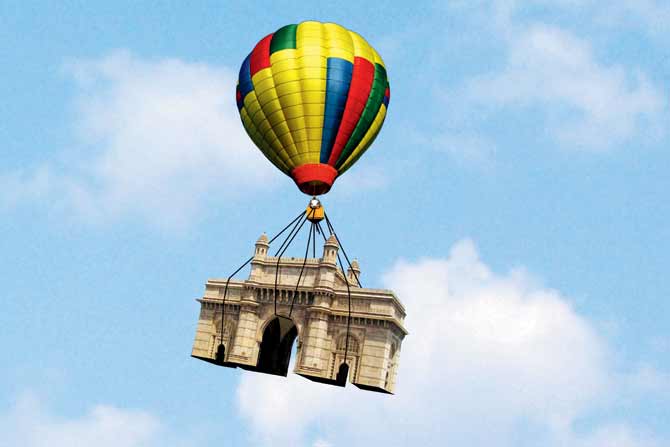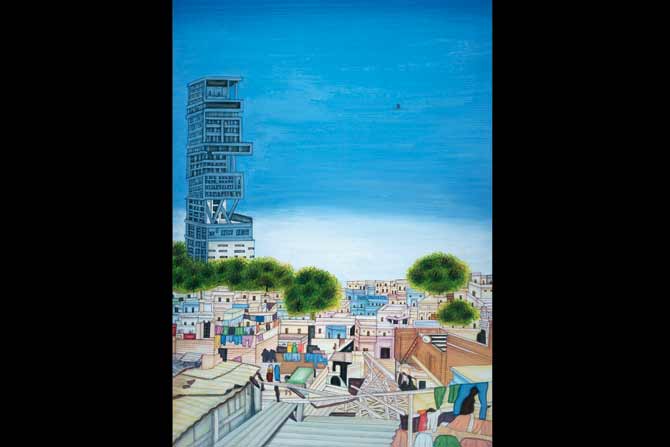Writer, artist, activist and architect Gautam Bhatia rolls all his talents together to satirise urban India, and discuss why it's a lost cause

Architect Gautam Bhatia with his bronze politicians
A city, the late American journalist Herb Caen once said, should not be "gauged by its length and width, but by the broadness of its vision and the height of its dreams". A careful reading of a new book, Delirious City: Polity and Vanity in Urban India (Niyogi Books) by Delhi-based architect Gautam Bhatia, shows how Caen's words were lost on the scriptwriters of the great Indian metropolises. The book as Bhatia writes in his preface, doesn't follow a linear narrative, but unfolds in multiple ways: "Like a sea voyage from Mumbai to London undertaken a century ago—two months on the high seas, with stops at Aden, Alexandria, Naples and Lisbon".
Delirious City could have easily been a handbook or manifesto on the making of the perfect urban square. Bhatia instead fuses his personal commentary with diaryentries, sketches, digital art and sculptures that "bleed together without any planned order" to weave a satire on urban planning. "The book is without a plan, without coherence and certainly without a clear intent. It is a private expression of public ideas," says Bhatia. "The problem is that the city usually cannot be expressed clearly in one medium. You can write about it, photograph it, draw it, even build it, but its complexity is always elusive. So, for me, the real thrust of the book was to present a multiple reading simultaneously."
ADVERTISEMENT
Bhatia admits that this exercise makes it a difficult book to read. "...but there it is. The idea was to weave anything and everything that helped to illustrate an urban idea—talk about people who try to convert two-bedroom houses into palaces, those who run dark little hotels and call them Royal Malibu Sheraton, all the pretentions and aggravations that spell my house, my city."

The Gateway of India on the move to a wedding location. Pic Courtesy/ Delirious City: Polity and Vanity in Urban India by Gautam Bhatia, Niyogi Books
Bhatia, whose architectural sensibilities are rooted and home-grown and informed by the earth, is but, the right candidate to critique the construction of cities. "One of the more interesting things about architecture as a profession is that it exposes you to a range of ideas and disciplines peripherally connected to building. Where else would you get to know about the secret lives of families when you design their houses, or see how uncomfortable people are in open plan offices, sitting face to face with their boss and subordinates. Architecture instructs you to probe and invent—you crawl your way through prolonged and painful associations, that make you tread into social life, culture, private fetish and idiosyncrasy, before you get to actually design and build. It is the only profession that follows no formula or rules. When it does follow rules, it produces a dreary mindless landscape—like public housing." Bhatia's lucid essays, which range from discussion on the ghetto life to the unoriginality of architecture and the intimacy of living in over-populous cities, are complemented with drawings that he uses to articulate issues he can't. A sketch of the ring of a commode with buildings along its edge, he says, seemed like "the best way to express the urban conditions along Marine Drive". A car-wash that takes the form of cars bathing in an expensive traditional bathtub is meant to be a statement of how much love we shower on a piece of fancy metal that clogs our roads and pollutes our lungs, explains Bhatia.
"Satire is absolutely essential to practising architecture in India, because it gives credit to something that is entirely humourless and conceived without a hint of irony. If it can't laugh at itself, a second rate urban culture has nothing to take its mind away from being second rate. Down the road from where I live is a house in the shape of a French chateau that has Rajasthani balconies and a Japanese pagoda roof with a large concrete chattri on the terrace. The owner sits there in the evening for his drink. The house in all seriousness is Marwari French Gothic," he shares.

Anthill to Antilla. Pic Courtesy/ Delirious City: Polity and Vanity in Urban India by Gautam Bhatia, Niyogi Books
Bhatia likes to describe the "private cities that exist in the larger public city", as schizophrenic. "Delhi, Mumbai, Bengaluru are unwieldy and impossible conglomerations of people who may never meet and often never do. The real space belongs to people who live their lives in a small perimeter of a neighbourhood—those that live and work close by, meet people at the market, that plan weddings in the colony... The vital signs of schizophrenia are fear and mistrust, and we've learnt to give them physical shape—guard dogs, CCTV cameras, electrified boundaries, guns in the glove compartment." The perfect city, Bhatia says, almost hopelessly, will always elude a country like India. Chandigarh was well-planned and so is Amravati. "But it is a mistake to build them in India. An ideal well-planned city in India is like making achaar with only one ingredient. The messy vibrant vitality of Indian life can only happen when cities are designed like joint families—everyone and everything intruding into the other till there is no expression of individuality. The only cities that can be called ideal are some traditional towns like Jodhpur, old Lucknow, etc. or urban villages like Haus Khaz in Delhi or Dharavi in Mumbai, where people live by self-created rules or no rules at all.
One way to determine what kind of planned city we want is to release 200 families onto a small piece of land and see what they build for themselves, then write the rule book."
 Subscribe today by clicking the link and stay updated with the latest news!" Click here!
Subscribe today by clicking the link and stay updated with the latest news!" Click here!







